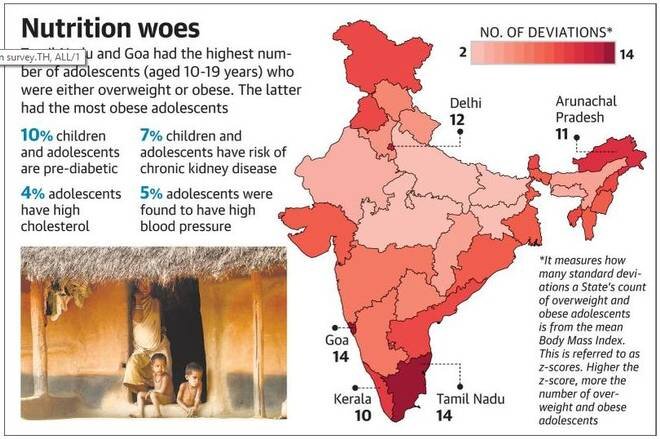National Nutrition Survey | 30 Sep 2019
The first-ever comprehensive National Nutrition Survey has been conducted by the Ministry of Health and Family Welfare and the United Nations Children Fund (UNICEF) to measure malnutrition.
- The survey recorded not only micronutrient deficiencies but also details of non-communicable diseases such as diabetes, hypertension, cholesterol and kidney function in children and adolescents.
Key findings
- Nearly 10% of children in the age group of 5-9 years and adolescents in the age group of 10-19 years are pre-diabetic.
- Also, 5% are overweight and another 5% suffer from blood pressure in the age groups mentioned above.
- The first time hard evidence of the coexistence of obesity and undernutrition, among school-going children has been recorded.
- The National Nutrition Survey is different from the National Family Health Survey (NFHS) as,
- NFHS collects data to measure the prevalence of stunting, wasting and underweight and household dietary intake to measure deficiencies.
- Moreover, the survey collects data only for the age groups of 1-5 years and adults, and not for school going children between the age of 5 and 19 years.
Steps Taken by Government of India to curb incidences of Malnutrition
- Under the Pradhan Mantri Matru Vandana Yojana (PMMVY), Rs.6,000 is transferred directly to the bank accounts of pregnant women for availing better facilities for their delivery.
- POSHAN Abhiyaan, launched in 2017-18, aims to reduce stunting, under-nutrition, anaemia and low birth weight babies through synergy and convergence among different programmes, better monitoring and improved community mobilisation.
- The National Food Security Act (NFSA), 2013, aims to ensure food and nutrition security for the most vulnerable through its associated schemes and programmes, making access to food a legal right.
- Mid-day Meal (MDM) scheme aims to improve nutritional levels among school children which also has a direct and positive impact on enrolment, retention and attendance in schools.
Malnutrition and Undernutrition
- Malnutrition refers to deficiencies, excesses or imbalances in a person’s intake of energy and/or nutrients.
- The term malnutrition covers two broad groups of conditions.
- Undernutrition—which includes stunting (low height for age), wasting (low weight for height), underweight (low weight for age) and micronutrient deficiencies (a lack of important vitamins and minerals).
- Obesity— which includes overweight and diet-related noncommunicable diseases (such as heart disease, stroke, diabetes, and cancer).

